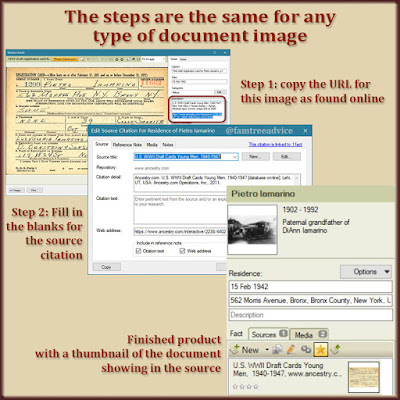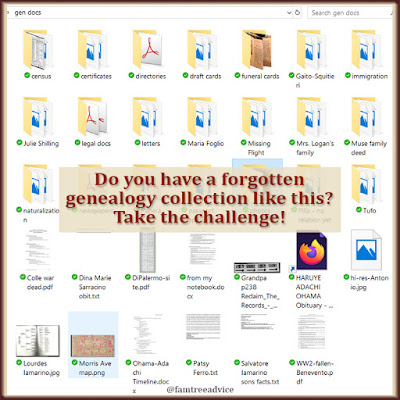When you find a big error in your family tree, examine all facts carefully.
While I was improving my source citations this week, I spotted a problem in my family tree. My cousin Silvio Saviano was no longer related to me.
How did Silvio's relationship to me change? As I dug into the facts in my tree and on Ancestry, I saw the problem. Silvio's father was Luigi, but I "gave" him to the wrong Luigi!
 |
| Without enough records for my little town, it was easy to confuse the 2 Luigi's. |
I have been writing and rewriting this article for 2 full days. I kept finding contradictory information. In the end, the solution was quite a surprise to me.
Here's how confusing it is.
Background
- My great grandmother was a Saviano. She came from a small village that has only 653 residents today. It's safe to say that every Saviano living there in the 19th century is my relative.
- This town's unusual history means there are no available birth records before 1861. And no marriage or death records before 1931.
- My mom knew Silvio Saviano and his family when she was growing up. She knew them as cousins.
Similarities
- Some of Silvio's U.S. records say his father was Luigi. There is no mention of his mother.
- In the town's available records, there are 2 men named Luigi Saviano born in the 1850s. That's based on the birth records of 16 children they had between them from 1878 to 1899.
- The Luigi born in 1858 is my 3rd great uncle. I have his 1938 Italian death record, and it names my 3rd great grandparents as his parents. Uncle Luigi stayed in Italy.
- The Luigi born in 1852 did come to America. So did at least 4 of his 11 children. I found U.S. death records for Luigi and 3 of his children.
- Only 1852 Luigi had a son named Silvio.
Silvio never gave the same birth date twice. Since I wanted him to belong to my 3rd great uncle Luigi, I figured he was born the year there are no records: 1895.
Sorting Out a Tangled Mess
After examining all the documents, it became clear that Silvio was NOT the son of my 3rd great uncle. He was the son of the other Luigi.
Do you have a confusing twist of same-named people in your family tree? It may help you to see how I came to realize which Luigi was the father of Silvio.
I know from his birth record that Silvio was born on 9 Oct 1896 to Luigi Saviano and Maria Grazia Guarente. He is the only Silvio Saviano in the town's available vital record collection.
 |
| It's hard to imagine, but our ancestors weren't always sure of their birth dates. |
Here's what I found in America:
- 1912 ship manifest with Luigi Saviano (age 60) and his son Silvio (age 15). The manifest clearly says that father and son are from Sant'Angelo a Cupolo. It says Luigi leaves behind a brother Giuseppe in Italy. That brother Giuseppe came to America in 1898. Either I have the wrong Giuseppe Saviano in 1898, or he went back to Italy.
- 1917 World War I draft registration card for Silvio. It gives his birth date as 16 Oct 1895 and his address as 253 East 151st Street, Bronx, New York.
- Two military transport manifests (31 Jul 1918 and 21 Apr 1919). Both mention his brother Joseph living at 630 Morris Avenue, Bronx, New York. That's around the corner. And Silvio does have a brother Giuseppe who came to America.
- 30 May 1918 petition for naturalization. This was my red herring. It gave his birth date as 12 Oct 1895. But it says he has lived in South Carolina since 1900. When I found another Silvio Saviano who became a citizen in Tennessee, I knew I had to delete this document.
- 17 November 1918 New York newspaper listing Silvio as severely wounded. His address is 630 Morris Avenue. His World War II draft registration card corroborates this. It says he has a "scar on left wrist and bullet scar on calf of right leg."
- 1920 military service record. This index card, unfortunately, uses the same birth date as the southern Silvio: 12 Oct 1895. It gives his address as 630 Morris Avenue and says he was inducted in New York City. It says he was "slightly" wounded on 12 Sep 1918 ("severely" is smudged out). It also says he was overseas from 31 Jul 1918 to 21 Apr 1919, which fits the military transport records exactly. It's good except for that pesky birth date.
- 1925 census. Silvio and his wife and 3 kids are living at 599 Morris Avenue. His kids' names are the ones my mom knew and grew up with. He's still an alien, which further rules out those 1918 naturalization papers.
- 1930 census. Silvio and family are on a different street nearby. He is finally a citizen. But it says he arrived in 1901. I do have a 1901 ship manifest for his father Luigi and 2 of his siblings. But not Silvio. Luigi had been detained while waiting for my 2nd great uncle, Semplicio Saviano. On the ship manifest Luigi calls Semplicio a relative. On the detainee list, he calls him his nephew. But he is not his nephew!
- 1942 World War II draft registration card, mentioned earlier. Silvio and his wife Mary are at another Bronx address,and his birthday is 9 Oct 1896. That is the very first time Silvio's birth date on a U.S. document actually matches his Italian birth record. It was only when I got to this last document that I realized the truth. Silvio is not the son of my 3rd great uncle.
I can't prove his relationship to me. But I can try to find the missing pieces. Luigi came to New York with 2 of his children, Maria and Giuseppe, in 1901. He made another trip in 1912—as a 60-year-old man—and brought back only his son Silvio. Luigi died in the Bronx in 1916 as a widower. Did his wife die in Italy? Is that why Luigi went back to fetch his youngest child, 15-year-old Silvio? When did Silvio's other sister Letizia come to America? She married and had a baby in the Bronx in 1905, dying 5 days later of complications. Her death record says she arrived in 1901. (I just realized she is not my only Letizia Saviano, and both died the same way!)
I need more immigration records. So far, they're eluding me. I'll bet Luigi is my 2nd great grandfather's 1st cousin, but I may never be able to prove it. For now I'll give the whole branch my blue "No Relationship Established" profile image and move on.
The lesson here is to stop what you're doing when you find a big error. You may forget about it and make more mistakes as a result. Take a step back and be objective. Examine all the facts you have, and then search for more.
So…who's all messed up in your family tree?
Here are some related articles you may have missed:









